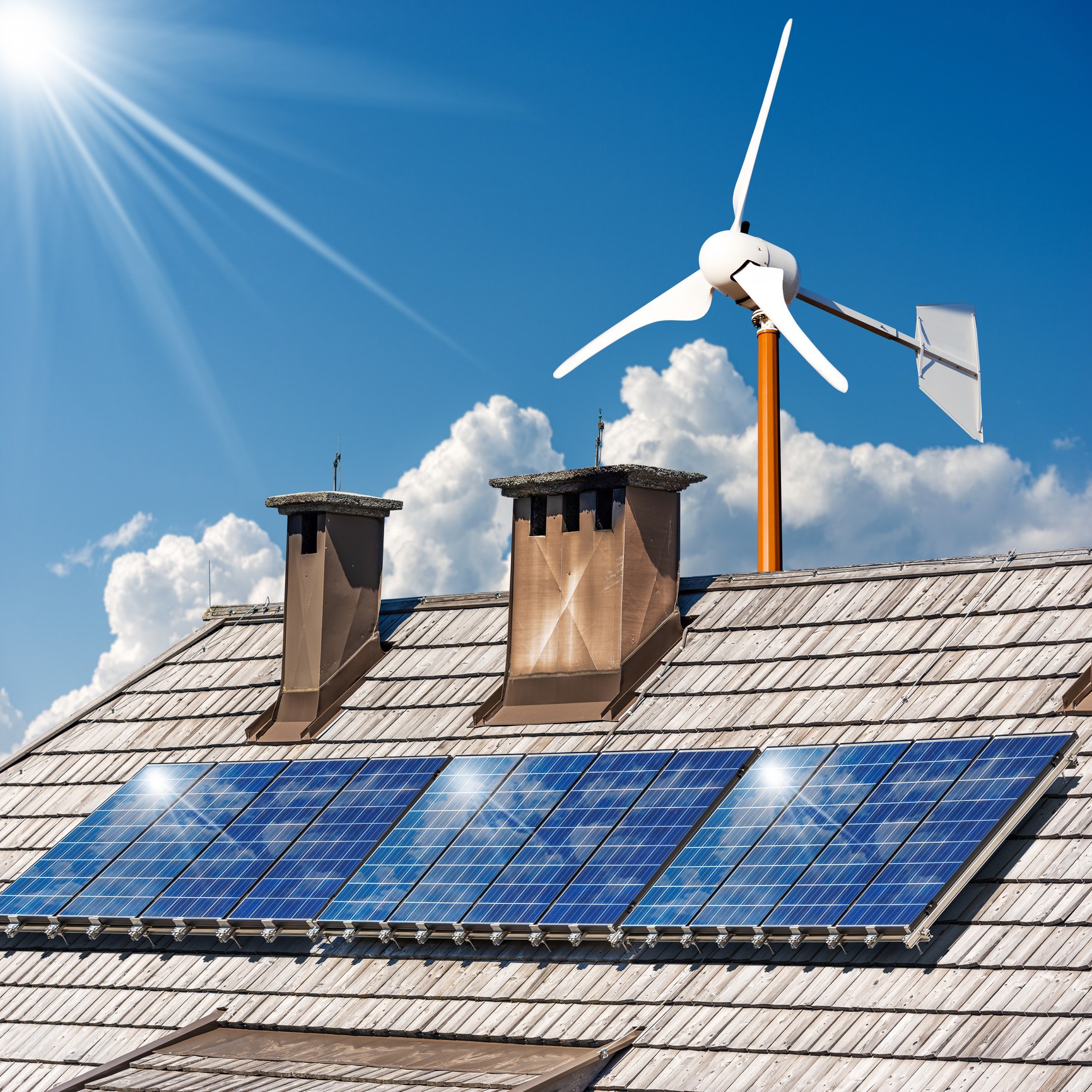
Our Energy Future: Solar Power
Read time: 4 minutes
Solar power is one of the UK’s fastest growing clean energy sources, with one in every 20 buildings in the UK utilising solar technologies, equating to over 1.2 million rooftops. Here, we explore what solar power is, how it works, and how it will help the UK deliver a clean energy future.
Solar power involves converting energy from the sun into electricity or heat. It is a clean energy source since it creates no harmful greenhouse gas emissions as it generates. So long as the sun shines it is considered and infinite source for electricity and heating.
Solar radiation, or electromagnetic radiation, is emitted by the sun and hits every location on Earth over the course of a year. Estimates suggest that the amount of sunlight striking the Earth in an hour and a half is enough to service the world’s energy consumption for a full year.
Electromagnetic radiation is harnessed and turned into electricity and heat using two primary methods, concentrated solar power farms, or photovoltaic solar panels. Here, we discuss how photovoltaic panels work, and how they are implemented to service energy demand.
Solar power converts energy from the sun into electricity or heat. This is generated using one of two solar panels: photovoltaic solar panels, otherwise known as solar PV, or solar thermal panels.
Solar PV is made from a semiconductor material, most commonly silicon, which is installed in a metal panel frame with a glass casing. When sunlight, known as photons, hits the panel, it is absorbed by the panel’s PV cells which release electrons, producing an electric charge. The solar PV then turns this charge into an electric direct current (DC). The solar PV’s inverter then converts the DC into alternating current (AC) which is an electrical current used for plug-in appliances and wall outlets.
As for solar thermal systems, these are used for heating. Solar thermal systems are typically installed on rooftops. These panels will absorb photons which are used to heat a fluid inside an insulated cylinder, usually a mixture of water and glycol which prevents water from freezing. This heated fluid is then pumped into a heat exchanger within a building and is used to heat water tanks. Once heat is taken from the fluid, it is then sent back to the solar thermal system.
When it comes to maximising the effectiveness of your solar power, Kevin Aisbitt, Innovation Project Manager at the Energy Innovation Agency, explains that monitoring and understanding your energy use is essential to this.
“We work with some clients whose biggest problems are monitoring,” said Kevin. “If you aren’t sure what [energy] you are using, when you are using it, or how it is being consumed, you won’t be able to get the most out of renewable energy and green technology solutions.”
“A great chunk of energy is used and wasted out of operating hours. Wasteful energy use can create the illusion that your solar power isn’t performing, when in fact your organisation is wasting the potential with inefficient energy consumption. If you’re unsure about energy usage, you will be unsure about savings and the potential of your solar.”
Solar power is an efficient and accessible means of renewable power generation, but barriers such as financing, knowledge gaps and tech uncertainty serve as key barriers to investment.
“There are several barriers people foresee when it comes to accessing solar power,” explains Kevin Aisbitt. “Firstly, there are misconceptions about the use of solar, such as sunniness and weather. While a solar panel is most effective on clear, sunny days, they absolutely do still work on cloudy days.”
“Another key barrier to solar concerns ownership and availability of space. A smaller site owned by a separate landlord will have to think more strategically about installing solar PV on their site compared to a property-owning business with a giant, south-facing roof. Understanding the costs, return on investment, and project timescales is a good starting point for pitching solar to your landlord,” says Kevin.
The UK solar market is being boosted by a variety of innovative solutions, making solar increasingly accessible and efficient.
“We’re working on a range of solar innovations at the Agency,” says Kevin. “These include solar thermal solutions, solar film, lightweight solar, battery storage solutions and micro-turbines to help bolster the supply of solar power.”
Solar thermal solutions = using solar power to heat water that is stored in a tank until needed
Solar film = durable, thin laminate which is applied to windows to reduce glare, sun damage, and reduce heat loss
Lightweight solar = thin-film, flexible solar panels which are more adaptable for a range of surfaces and environments
Battery storage solutions = lithium-ion or lead-acid batteries that store excess solar power for use at later periods when the sun isn’t as strong
Micro-turbines = small turbines using rotational energy to generate power, these can be used alongside solar panels to bolster energy supply
Bifacial solar panels = made up of monocrystaline cells, with panels having a reflective back or dual panes of glass


(Pictured above: solar panels coupled with a micro turbine)


On a larger, more industrial scale, concentrated solar power (CSP) is being used to cover large areas of land and direct sunlight onto single receivers. For an in-depth explanation as to how this works, read our Concentrated Solar Power Guide.
MCS has certified over 1.7 million installations across the UK, with over 220,500 of these installations being registered in 2023 alone. As the UK government announces a variety of renewable energy policies geared towards boosting the supply of solar, the annual growth rate of solar energy is expected to reach 23.53 per cent between 2023 and 2028. This equates to a growth from 15 GW in 2023 to 43 GW of UK solar power by 2028.
The UK government aims to achieve grid decarbonisation primarily through a combination of wind and solar energy. This means achieving 70 GW of installed solar power by 2035. The size of a solar project determines the speed and ease with which they are developed. Solar farms with capacity below 50 MW need local planning authority permission, while projects which exceed 50 MW need development consent from the Secretary of State for Energy Security and Net Zero.
Presently, the UK’s largest solar farm is located in Shotwick, Chester, with a capacity of 72.2 MW, covering an area of 250 acres comprised of 277,728 solar panels. Shotwick produces enough energy to power 18,055 average households a year. This farm is followed by Lyneham solar farm in Wiltshire, generating 69.8 MW across 213.3 acres, and then Wroughton Airfield with 60.6 MW across 172 acres.


Do you have questions about solar power? See our FAQs below, answered by Green Economy Consultant Priya Sirpal. Priya works with end-users to identify opportunities for solar, and partner organisations with the right supplier. If you'd like to speak to Priya about solar installation, contact her via email: priya@greeneconomy.co.uk
Yes. Solar panels are most effective when the sun is clearly shining, but they still work on cloudy days by absorbing energy from the light spectrum, and photons which can pass through thick clouds.
A typical solar panel will save upwards of 900kg of CO2 per year. A rooftop solar panel has a carbon footprint roughly 12 times lower than natural gas.
It takes roughly 6 to 7 years for a solar panel to offset its own embedded carbon.
With average rainfall in the UK, most solar panels are self-cleaning. However, location will depend on maintenance. If your site is near trees and forestry, there will be more maintenance required to clear debris or account for birds. In addition, sites located in “dirty air zones” will also need to put more effort into cleaning and upkeep.
Regulation states your solar panels will need an electricity check every 5 years, but installers recommend doing so every year.
This varies from site to site. Your installer will conduct a feasibility study prior to installation to assess your organisation’s capacity for solar.
Timescales will vary depending on the scale of your project, but the average solar installation is completed within 2 days.
If you do not own the property you operate from, you will need to liaise with your landlord to obtain the necessary permissions. Furthermore, planning permission is needed for properties that are listed buildings, located on heritage sites, or involve an installation process outside of normal guidelines.
Any combination of the following accreditations are industry standards for solar installers:
In partnership with:
The UK Shared Prosperity Fund is a central pillar of the UK government’s Levelling Up agenda and provides £2.6 billion of funding for local investment by March 2025. The Fund aims to improve pride in place and increase life chances across the UK investing in communities and place, supporting local business, and people and skills. For more information, visit https://www.gov.uk/government/publications/uk-shared-prosperity-fund-prospectus
The UK Shared Prosperity Fund is a central pillar of the UK government’s Levelling Up agenda and provides £2.6 billion of funding for local investment by March 2025. The Fund aims to improve pride in place and increase life chances across the UK investing in communities and place, supporting local business, and people and skills. For more information, visit https://www.gov.uk/government/publications/uk-shared-prosperity-fund-prospectus
This project is funded by the UK Government through the UK Shared Prosperity Fund.
The UK Shared Prosperity Fund is a central pillar of the UK government’s Levelling Up agenda and provides £2.6 billion of funding for local investment by March 2025. The Fund aims to improve pride in place and increase life chances across the UK investing in communities and place, supporting local business, and people and skills. For more information, visit https://www.gov.uk/government/publications/uk-shared-prosperity-fund-prospectus